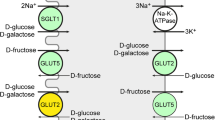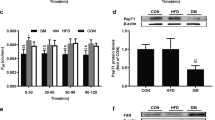Summary
The aim is to investigate the influence of the antidiabetic drug gliclazide on the ileal permeation of the semisynthetic bile acid, MKC, in tissues from healthy and diabetic rats. Sixteen Wistar rats (350±50 g) were randomly allocated into four groups (4 rats per group, 8 chambers per rat i.e. n=32) two of which were made diabetic (given alloxan i.v.30 mg/kg). Group 1 was used to measure the permeation of MKC (50 μg/ml) alone (control) while group 2 to measure MKC permeation in the presence of gliclazide (200μg/ml). The diabetic groups 3 (gliclazide) and 4 (MKC+gliclazide) were treated in the same way. Rats were sacrificed and tissues were mounted into the Ussing chamber for the measurement of MKC mucosal to serosal (absorptive) and serosal to mucosal (secretory) fluxes. In healthy tissues, gliclazide reduced MKC absorptive flux (p<0.01) and increased its secretory flux (p<0.01). In diabetic tissues, gliclazide had no effect on either the absorptive or the secretory fluxes of MKC. The lack of effect of gliclazide on MKC permeation in diabetic tissues suggests the absence or suppressed drug transporters. Furthermore, gliclazide inhibition of MKC absorptive flux and induction of MKC secretory flux in healthy tissues may result from the selective inhibition of an efflux drug transporter.
Similar content being viewed by others
Reference
Yaris F., Yaris E., Kadioglu M., Ulku C, Kesim M., Kalyoncu N.I. (2004): Normal pregnancy outcome following inadvertent exposure to rosiglitazone, gliclazide, and atorvastatin in a diabetic and hypertensive woman. Reprod. Toxicol., 18, 619–621.
Rendell M. (2004): The role of sulphonylureas in the management of type 2 diabetes mellitus. Drugs, 64, 1339–1358.
Faure P., Rossini E., Wiernsperger N., Richard M.J., Favier A., Halimi S. (1999): An insulin sensitizer improves the free radical defense system potential and insulin sensitivity in high fructose-fed rats. Diabetes, 48, 353–357.
Nöda Y., Mori A., Packer L. (1997): Gliclazide scavenges hydroxyl, superoxide and nitric oxide radicals: an ESR study. Res. Commun. Mol. Pathol. Pharmacol., 96, 115–124.
Florkowski CM., Richardson M.R., Le Guen C, Jennings P.E., O’Donnell M.J., Jones A.F., et al. (1988): Effect of gliclazide on thromboxane B2, parameters of haemostasis, fluorescent IgG and lipid peroxides in non-insulin dependent diabetes mellitus. Diabetes Res., 9, 87–90.
Stetinova V., Kvetina J., Pastera J., Polaskova A., Prazakova M. (2007): Gliclazide: pharmacokinetic-pharmacodynamic relationships in rats. Biopharm. Drug Dispos., 28, 241–248.
Al-Salami H., Butt G., Tucker I., Mikov M. (2009): The influence of probiotics pre-treatment, on gliclazide PKs and glucose levels in healthy and diabetic rats. Eur. J. Drug Metabol. Pharmacokinet. In press.
Tsiani E., Ramlal T., Leiter LA., Klip A., Fantus I.G. (1995): Stimulation of glucose uptake and increased plasma membrane content of glucose transporters in L6 skeletal muscle cells by the sulfonylureas gliclazide and glyburide. Endocrinology, 136,2505–2312.
Mikov M., Al-Salami H., Fawcett J.P. (2008): The influence of 3a,7a-dihydroxy-12-keto-5β-cholanate on gliclazide pharmacokinetics and glucose levels in a rat model of diabetes. Eur. J. Drug Metabol. Pharmacokinet., 33, 137–142.
Garcia-Bournissen F., Feig D.S., Koren G. (2003): Maternalfetal transport of hypoglycaemic drugs. Clin. Pharmacokinet., 42, 303–313.
Campbell D.B., Lavielle R., Nathan C. (1991): The mode of action and clinical pharmacology of gliclazide: a review. Diabetes Res. Clin. Pract., 14(Suppl 2), S21–36.
Smith C.L., Hammond G.L. (1991): An amino acid substitution in biobreeding rat corticosteroid binding globulin results in reduced steroid binding affinity. J. Biol. Chem., 266, 18555–18559.
Werle M., Hoffer M. (2006): Glutathione and thiolated chitosan inhibit multidrug resistance P-glycoprotein activity in excised small intestine. J. Control. Release, 111(1–2), 41–46.
Al-Salami H., Butt G., Tucker I., Mikov M. (2008): Influence of the semisynthetic bile acid (MKC) on the ileal permeation of gliclazide in healthy and diabetic rats. Pharmacol. Rep., In press.
Li J., Hidalgo I.J. (1996): Molecular modeling study of structural requirements for the oligopeptide transporter. J. Drug Target, 4, 9–17.
Al-Salami H., Butt G., Tucker I., Mikov M. (2008): Influence of the semisynthetic bile acid MKC on the Ileal Permeation of Gliclazidein vitro in Healthy and Diabetic Rats treated with Probiotics. Methods Find. Exp. Clin. Pharmacol., 30(2), 1–7.
Chan L.M., Lowes S., Hirst B.H. (2004): The ABCs of drug transport in intestine and liver: efflux proteins limiting drug absorption and bioavailability. Eur. J. Pharm. Sei., 21, 25–51.
Lucas M.L. (2005): Amendments to the theory underlying Ussing chamber data of chloride ion secretion after bacterial enterotoxin exposure. J. Theor. Biol., 234, 21–37.
Hunter J., Hirst B.H. (1997): Intestinal secretion of drugs. The role of P-glycoprotein and related drug efflux systems in limiting oral drug absorption. Adv. Drug Del. Rev., 25, 129–157.
Evers R., Kool M., van Deemter L., Janssen H., Calafat J., Oomen L.C, et al. (1998): Drug export activity of the human canalicular multispecific organic anion transporter in polarized kidney MDCK cells expressing cMOAT (MRP2) cDNA. J. Clin. Invest., 101, 1310–1319.
Fromm M., Kauffamnn H., Fritz P., Burk O., Kroemer H., Warzok R., et al. (2000): The effect of rifampin treatment on intestinal expression of human MRP transporters. Am. J. Pathol., 157, 1575–1580.
Sauna Z., Smith M., Müller M., Kerr K., Ambudkar S. (2001): The mechanism of action of Multidrug-resistancelinked P-glycoprotein. J. Bioenerg. Biomembran., 33, 481–491.
Ito K., Suzuki H., Horie T., Sugiyama Y. (2005): Apical/basolateral surface expression of drug transporters and its role in vectorial drug transport. Pharm. Res., 22, 1559–1577.
St-Pierre M.V., Kullak-Ublick G.A., Hagenbuch B., Meier P.J. (2001): Transport of bile acids in hepatic and non-hepatic tissues. J. Exp. Biol., 204, 1673–1686.
Zelcer N., van de Wetering K., Hillebrand M., Sarton E., Kuil A., Wielinga P.R., et al. (2005): Mice lacking multidrug resistance protein 3 show altered morphine pharmacokinetics and morphine-6-glucuronide antinociception. Proc. Natl. Acad. Sei. USA, 102, 7274–7279.
Zollner G., Marschall H.U., Wagner M., Trauner M. (2006): Role of nuclear receptors in the adaptive response to bile acids and cholestasis: pathogenetic and therapeutic considerations. Mol. Pharm., 3, 231–251.
Miljkovic D., Kuhajda K., J. H. (1996): Selective C-12 oxidation of cholic acid. Chem. Res., 2, 106–107.
Mikov M., Boni N.S., Al-Salami H., Kuhajda K., Kevresan S., Golocorbin-Kon S., et al. (2007): Bioavailability and hypoglycemic activity of the semisynthetic bile acid salt, sodium 3alpha,7alpha-dihydroxy-12-oxo-5beta-cholanate, in healthy and diabetic rats. Eur. J. Drug Metabol. Pharmacokinet., 32, 7–12.
DeCarvalhoI E., CarvalhoII N., Ferreira. L. (2003): Experimental model of induction of diabetes mellitus in rats. Acta Cirurgica Brasileira, 18, 120–167.
Butt A.G., Mathieson S.E., McLeod B.J. (2002): Electrogenic ion transport in the intestine of the Australian common brushtail possum, Trichosurus vulpecula: indications of novel transport patterns in a marsupial. J. Comp. Physiol. [B] 172,495–502.
Boisset M., Botham R.P., Haegele K.D., Lenfant B., Pachot J.I. (2000): Absorption of angiotensin II antagonists in Ussing chambers, Caco-2, perfused jejunum loop and in vivo: importance of drug ionisation in the in vitro prediction of in vivo absorption. Eur. J. Pharm. Sei., 10, 215–224.
Mäher S., Feighery L., Brayden D.J., McClean S. (2007): Melittin as a permeability enhancer II: in vitro investigations in human mucus secreting intestinal monolayers and rat colonic mucosae. Pharm. Res., 24, 1346–1356.
Sun Y.Q., Soderholm J.D., Petersson F., Borch K. (2004): Long-standing gastric mucosal barrier dysfunction in Helicobacter pylori-induced gastritis in mongolian gerbils. Helicobacter, 9, 217–227.
Venkatraman A., Ramakrishna B.S., Pulimood A.B., Patra S., Murthy S. (2000): Increased permeability in dextran sulphate colitis in rats: time course of development and effect of butyrate. Scand. J. Gastroenterol., 35, 1053–1059.
Bodo A., Bakos E., Szeri F., Varadi A., Sarkadi B. (2003): Differential modulation of the human liver conjugate transporters MRP2 and MRP3 by bile acids and organic anions. J. Biol. Chem., 278, 23529–23537.
Zelcer N., Saeki T., Bot I., Kuil A., Borst P. (2003): Transport of bile acids in multidrug-resistance-protein 3-overexpressing cells co-transfected with the ileal Na+-dependent bile-acid transporter. Biochem. J., 369, 23–30.
Zollner G., Fickert P., Fuchsbichler A., Silben D., Wagner M., Arbeiter S., et al. (2003): Role of nuclear bile acid receptor, FXR, in adaptive ABC transporter regulation by cholic and ursodeoxycholic acid in mouse liver, kidney and intestine. J. Hepatol., 39, 480–488.
Cvetkovic M., Leake B., Fromm M.F., Wilkinson G.R., Kim R.B. (1999): OATP and P-glycoprotein transporters mediate the cellular uptake and excretion of fexofenadine. Drug Metab. Dispos., 27, 866–871.
Mita S., Suzuki H., Akita H., Hayashi H., Onuki R., Hofmann A.F., et al. (2006): Inhibition of bile acid transport across Na+/taurocholate cotransporting polypeptide (SLC10A1) and bile salt export pump (ABCB 11)-coexpressing LLC-PK1 cells by cholestasis-inducing drugs. Drug Metab. Dispos., 34, 1575–1581.
Ballatori N., Christian W.V., Lee J.Y., Dawson P.A., Soroka C.J., Boyer J.L., et al. (2005): OSTalpha-OSTbeta: a major basolateral bile acid and steroid transporter in human intestinal, renal, and biliary epithelia. Hepatology, 42, 1270–1279.
Houten S., Watanabe M., Auwerx J. (2006): Endocrine functions of bile acids. EMBO J., 25, 1419–1425.
Author information
Authors and Affiliations
Rights and permissions
About this article
Cite this article
Al-Salami, H., Butt, G., Tucker, I. et al. Gliclazide reduces MKC intestinal transport in healthy but not diabetic rats. Eur. J. Drug Metabol. Pharmacokinet. 34, 43–50 (2009). https://doi.org/10.1007/BF03191383
Received:
Issue Date:
DOI: https://doi.org/10.1007/BF03191383




